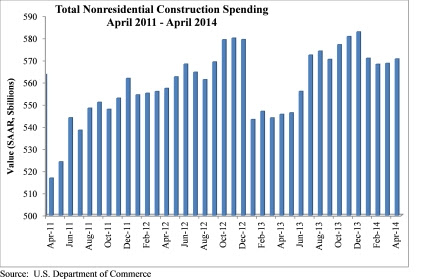Nonresidential construction spending inched up in April according to the June 2 release by the U.S. Census Bureau. This is the second consecutive month spending has increased following March’s upwardly revised spending report.
Nonresidential construction spending expanded by 0.4% on a monthly basis in April and has risen 3.9% on a year-over-year basis. Spending for the month totaled $570.6 billion on a seasonally adjusted, annualized basis.
“Unsurprisingly, nonresidential construction spending has improved with the weather,” said Associated Builders and Contractors Chief Economist Anirban Basu. “As a result of the unusually harsh winter weather, spending declines appeared large during the winter months and subsequent monthly gains have perhaps been a bit exaggerated as well. While the monthly numbers may be skewed, the year-over-year advance of 3.9% seems to realistically capture the rate of improvement in nonresidential construction spending.”
“The U.S. economy has recovered its momentum since the first quarter, suggesting that nonresidential construction’s steady recovery will remain in place,” said Basu. “Indeed, measures of business confidence have improved significantly and there are indications that capital spending is set to accelerate.”
Ten of 16 nonresidential construction subsectors posted increases in spending in April.
• Lodging construction spending is up 1.9% on a monthly basis and is up 16.9% on a year-over-year basis.
• Office-related construction spending grew by 1.7% in April and is up 20% from the same time one year ago.
• Construction spending in the transportation category expanded 3.4% on a monthly basis and has expanded 8% on an annual basis.
• Religious spending grew 1.8% for the month but is down 5.9% from the same time last year.
• Education-related construction spending gained 2.7% for the month and is up 2.9% on a year-over-year basis.
• Commercial construction spending rose 1.2% in April and is up 5.9% on a year-over-year basis.
• Sewage and waste disposal-related construction spending gained 4% for the month but has fallen 5.5% from the same time last year.
• Amusement and recreation-related construction spending expanded 4.4% on a monthly basis and is up 3.2% from the same time last year.
• Health care-related construction spending grew 0.9% for the month, but is down 6.2% on a year-over-year basis.
• Conservation and development-related construction spending expanded by 3.6% for the month and is up 19.7% on an annual basis.
Spending in six nonresidential construction subsectors declined in April.
• Spending in the water supply category fell 0.2% on the month and is down 12.8% from the same time last year.
• Manufacturing-related spending fell 1.1% on a monthly basis, but is up 6.7% on an annual basis.
• Highway and street-related construction spending fell 1.1% in April, but is up 4.8% compared to the same time last year.
• Communication construction spending was down 11.7% for the month but is up 21% from the same time one year ago.
• Public safety-related construction spending fell 0.9% on a monthly basis and has declined 12.4% on a year-over-year basis.
• Power construction spending dipped 1.2% for the month and was 1.6% lower than the same time one year prior.
Related Stories
| Aug 11, 2010
City of Anaheim selects HOK Los Angeles and Parsons Brinckerhoff to design the Anaheim Regional Transportation Intermodal Center
The Los Angeles office of HOK, a global architecture design firm, and Parsons Brinckerhoff, a global infrastructure strategic consulting, engineering and program/construction management organization, announced its combined team was selected by the Anaheim City Council and Orange County Transportation Authority (OCTA) to design phase one of the Anaheim Regional Transportation Intermodal Center.
| Aug 11, 2010
GBCI launches credentialing maintenance program for current LEED APs
The Green Building Certification Institute (GBCI) launched a credentialing maintenance program (CMP) for LEED APs and Green Associates, ensuring that LEED professional credentials will remain relevant and meaningful in a rapidly evolving marketplace.
| Aug 11, 2010
Construction employment shrinks in 319 of the nation's 336 largest metro areas in July, continuing months-long slide
Construction workers in communities across the country continued to suffer extreme job losses this July according to a new analysis of metropolitan area employment data from the Bureau of Labor Statistics released today by the Associated General Contractors of America. That analysis found construction employment declined in 319 of the nation’s largest communities while only 11 areas saw increases and six saw no change in construction employment between July 2008 and July 2009.
| Aug 11, 2010
Green consultant guarantees LEED certification or your money back
With cities mandating LEED (Leadership in Energy and Environmental Design) certification for public, and even private, buildings in growing numbers, an Atlanta-based sustainability consulting firm is hoping to ease anxieties over meeting those goals with the industry’s first Green Guaranteed.
| Aug 11, 2010
Architecture Billings Index bounces back after substantial dip
Exhibiting a welcome rebound following a 5-point dip the month prior, the Architecture Billings Index (ABI) was up almost 6 points in July. As a leading economic indicator of construction activity, the ABI reflects the approximate nine to twelve month lag time between architecture billings and construction spending. The American Institute of Architects (AIA) reported the July ABI rating was 43.1, up noticeably from 37.7 the previous month.
| Aug 11, 2010
Rafael Vinoly-designed East Wing opens at Cleveland Museum of Art
Rafael Vinoly Architects has designed the new East Wing at the Cleveland Museum of Art (CMA), Ohio, which opened to the public on June 27, 2009. Its completion marks the opening of the first of three planned wings.
| Aug 11, 2010
National Association of Governors adopts AIA policy of reaching carbon neutrality in buildings by 2030
As part of their comprehensive national Energy Conservation and Improved Energy Efficiency policy, the National Association of Governors (NGA) has adopted the promotion of carbon neutral new and renovated buildings by 2030 as outlined by the American Institute of Architects (AIA).








